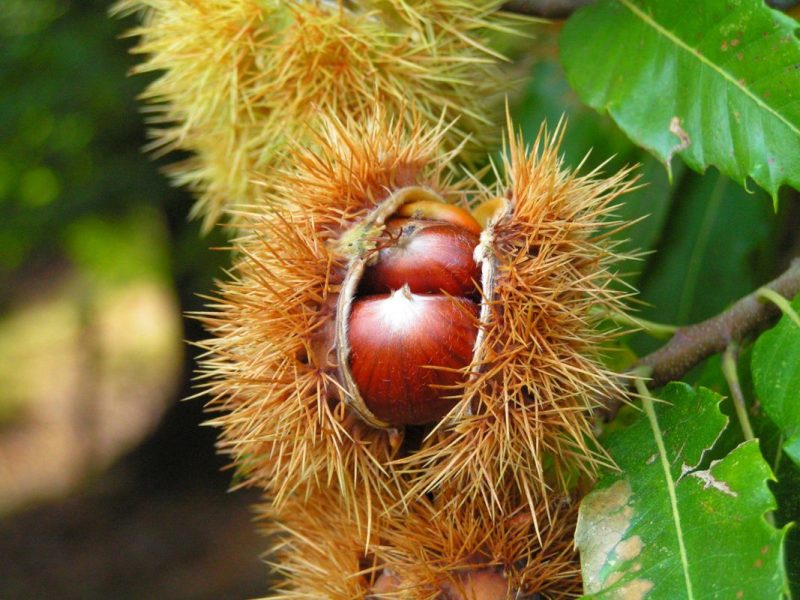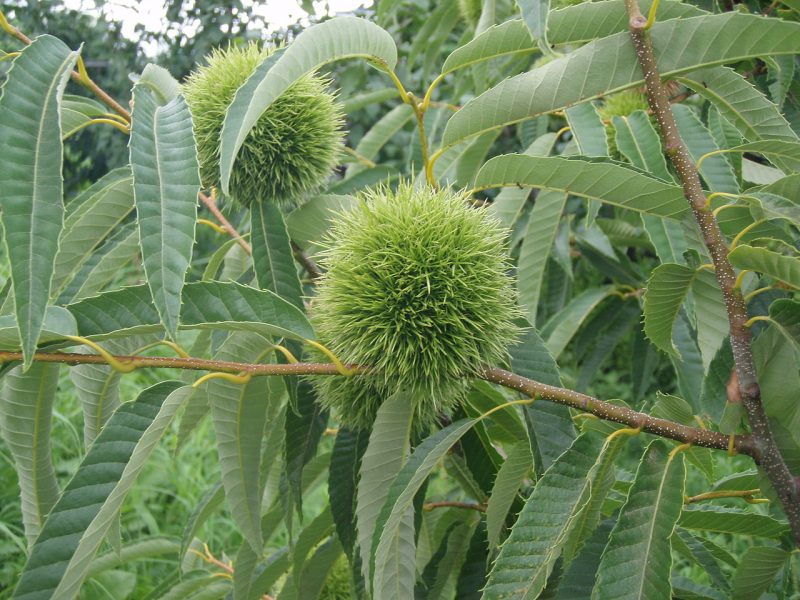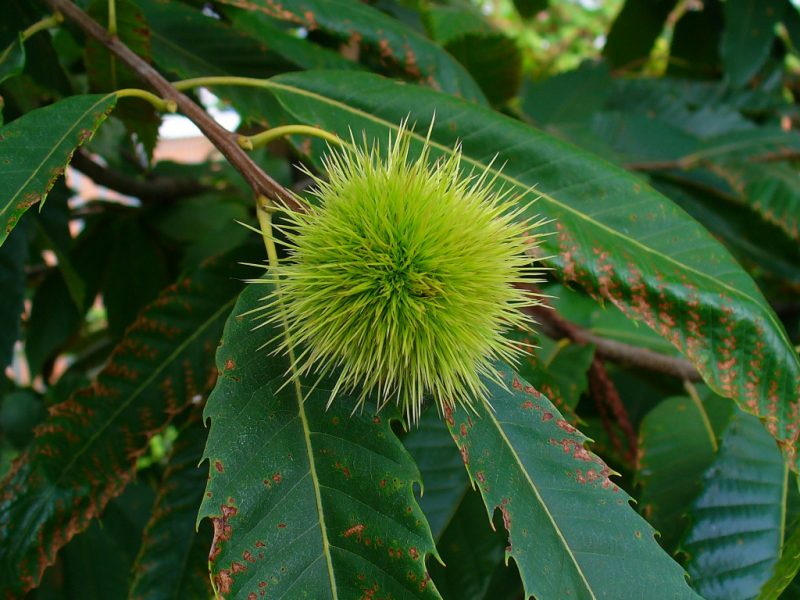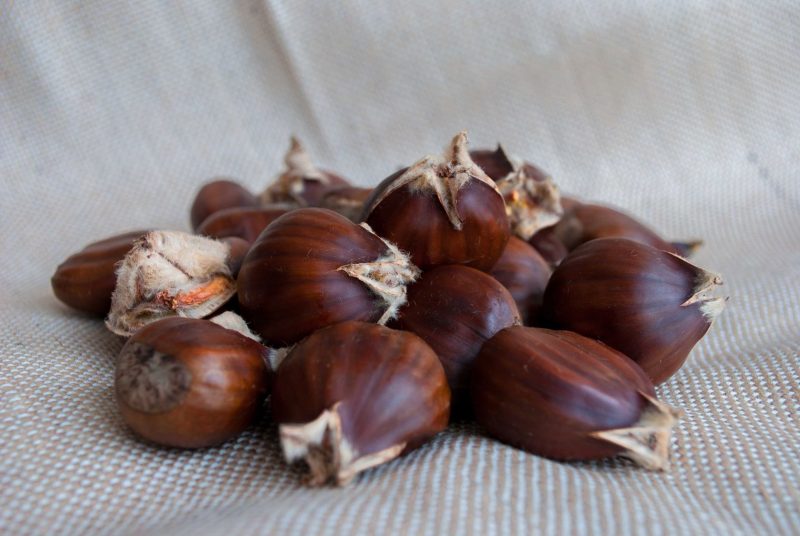Edible chestnut is also mentioned under other names: real, noble. This thermophilic plant safely develops and bears fruit in the southern regions. In temperate latitudes, it is reluctant to take root, gardeners who know the specifics of planting and care manage to get it on the site.
Material Content:
How to distinguish edible and inedible chestnuts?
These trees got the same name because of the outward similarity of smooth brown nuts, but differ in botanical classification and other outward signs. The inedible horse chestnut belongs to the Sapindov family, the noble chestnut belongs to the Bukovs.

Of the 10 species in Russia, sowing or Castanea sativa is more common, you can compare it with inedible chestnut according to the table:
| External characteristics | Horse | Noble |
|---|---|---|
| Height | 10 - 25 m | up to 35 m |
| Leaves | Placed in a group of 5 - 7 pieces on a large petiole, plate length 15 - 20 cm. | Grow alone on a short stalk, elongated-oblong form with denticles along the edges, length 10 - 28 cm. |
| Inflorescences | Pistoid, have a pyramidal shape. Grow up. | Spike-shaped 15 cm long, 2 cm in diameter. |
| Flowers | Bell-shaped white and pinkish color. Disclosed in May-June. | Pale yellow, greenish. Blossom in June-July. |
| Nut shell | Smooth green green with rare spikes, bursts when ripe. | The surface is covered with long thick spines, a crack appears in the fall. The color is first green, then brown. |
| Fruit | Inside the shell, one rounded bitter nut is formed, larger than the edible one. | Under the plus, 3 to 4 nucleoli of a sweet taste develop. Ripening occurs in October-November. |
Noble chestnut nuts are eaten raw and fried as an independent delicacy; they are used to prepare flour, desserts, salads, second and first courses. Horse chestnut kernels are used in pharmaceuticals for the preparation of tinctures and ointments.
Where grows edible chestnut Castanea sativa
The plant easily takes root in regions with a subtropical and humid temperate climate, grows in nature and is cultivated in the countries of the Mediterranean and Southeast Europe, in Armenia, Abkhazia, and Azerbaijan.

On the territory of Russia grows in the Krasnodar Territory, Crimea, the republics of the Caucasus. To the north of these regions in vivo does not occur. Attempts to grow in the middle lane are sometimes pumped successfully: seedlings freeze, but survive, grow stronger with age and become more resistant to frost.
Features of growing a tree
Chestnut sativa in winter withstands frosts up to 18 degrees.

Before landing, the following factors are considered:
- The plant loves light and warmth, develops better in a sunny, calm place. It also grows in the shade, but it blooms worse and bears fruit.
- The krone increases to 3-4 meters in diameter, so for normal growth you need up to 5 meters of free space without other landings and buildings.
- Stagnation and excess water destroys the plant, it is important to drain the soil before planting.
- Chestnut prefers loamy chernozem mixed with sand with neutral or weak acidity of 5 - 6. Lime soil is not suitable.
In regions with prolonged frosts below 20 ° C, it is better to choose other types of chestnut with edible nuts: American serrated or Japanese town. They are able to withstand frosts up to 28 ° C.
How to plant a seed chestnut

The plant is grown from seedlings or nucleoli. The first method is often used in areas with mild winters, the second is suitable for the middle lane, subsequently seedlings are better acclimatized.
Read also:how dates grow
Planting seedlings
Young plants are planted in the spring.

The process consists of the following steps:
- Dig a cubic hole with a depth and width of 0.5 m.
- 200 g of mineral fertilizers with potassium, nitrogen, phosphorus are added to the bottom, drainage is laid out from a mixture of crushed stone and sand 20 cm high.
- The soil is mixed with humus and sand in a ratio of 1: 0.5: 0.5, if the soil is acidic, add 500 g of dolomite flour.
- The bottom is sprinkled with a prepared substrate, watered with water, a seedling is placed in the center of the pit, covered with soil, lightly compacted.
- The planting hill is elevated 15 cm above the ground, taking into account subsidence of the soil. The root neck is placed 8 cm above the knoll.
In conclusion, the seedling is tied to the support from 4 sides and watered with two buckets of warm water, moisturized again after a week.
Seed planting
For germination, fresh, undamaged, hard nuts are used, they are collected in the autumn after ripening from the ground. Landing begins in November or March. In autumn, this will take less time: plants develop according to the natural cycle.

The nucleoli are placed in a container with sand and incubated for 10-14 days in a cool place at a temperature of 6 ° C. Then they are planted in open ground: they dig holes 6 cm deep, put a nut on the bottom and warm it with a layer of leaves 10 cm thick, do not throw it with earth. To protect against rodents, plantings are covered with metal wire boxes. Shoots appear by spring, leaving strong and viable on the site.
In regions with harsh winters and spring frosts, it is better to grow seedlings at home:
- The main condition for successful growth is to withstand the nuts in the cold, so from the fall they are placed in a container with sand and stored for 4 - 5 months in a refrigerator, cellar at a temperature of 6 ° C or a container is dug in the area.
- In early March, the nuts are taken out and soaked for 5-6 days to soften the shell and accelerate the formation of embryos, the water is constantly changed.
- When sprouts appear, they are planted in separate containers with a moist substrate.Drainage is laid at the bottom of the container, special soil is not required, soil from the store will do. Wells are best done to a depth of 4 cm: at a greater distance, the sprouts will not sprout, with a surface landing, the nuts dry out.
- The pot is placed in a sunny place, periodically watered. Shoots germinate after 2 to 3 weeks, they are transferred to the site at the end of May.
With a home planting, germination is higher; by the next winter, seedlings grow stronger and better tolerate frost. In cold regions, seedlings are left in the greenhouse for the first 3 years, in the summer they are put outside.
Outdoor Care

Seedlings need care the first 4 years, it includes the following items:
- Watering. Seedlings are watered regularly when the soil dries. Moisture will help strengthen the root system faster. Adult plants need only severe drought.
- Food. The tree is fertilized once a season in the spring: 1 kg of cow manure, 20 g of mineral fertilizing and nitrate, 10 g of urea are dissolved in 15 liters of water. Before applying in the soil, it is better to pierce holes with a depth of 30 cm, so that the fertilizer penetrates the soil.
- Crown formation. The chestnut is cut off before the buds swell in early spring: the upper shoots are shortened by a quarter, and frozen branches growing inside are removed.
- Caring for the trunk circle. The soil is loosened 3 times per season, weeds are removed, mulched in late autumn: covered with a layer of fallen leaves or peat 15 cm thick. Sawdust increases the acidity of the soil, it is better to refuse them.
- Pest protection. More often the tree is affected by chestnut moth, powdery mildew and woody mite. For prophylaxis, the leaves are sprayed twice a month with fungicides, karbofos; to combat moths, a Lufox 105 solution is used.
If you follow the recommendations of experienced gardeners, the chestnut will decorate the site, begin to bear fruit 8 years after planting, and will live up to half a century or more.












